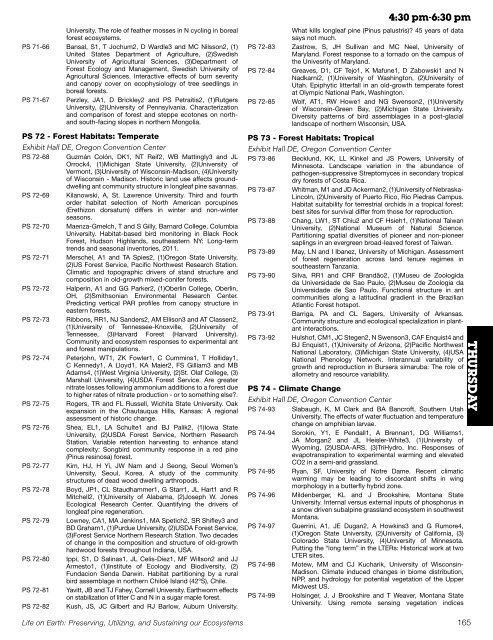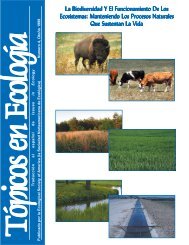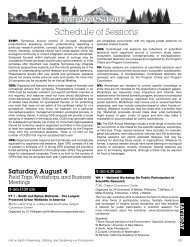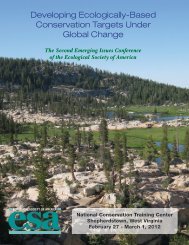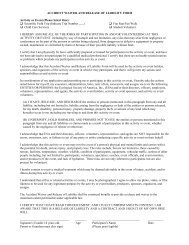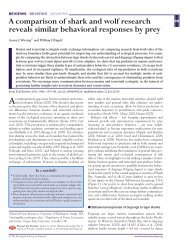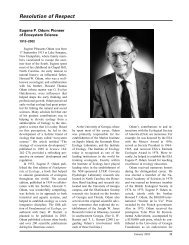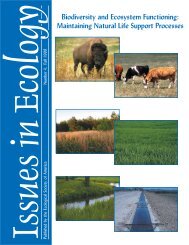Printed Program (PDF) - Ecological Society of America
Printed Program (PDF) - Ecological Society of America
Printed Program (PDF) - Ecological Society of America
You also want an ePaper? Increase the reach of your titles
YUMPU automatically turns print PDFs into web optimized ePapers that Google loves.
University. The role <strong>of</strong> feather mosses in N cycling in boreal<br />
forest ecosystems.<br />
PS 71-66 Bansal, S1, T Jochum2, D Wardle3 and MC Nilsson2, (1)<br />
United States Department <strong>of</strong> Agriculture, (2)Swedish<br />
University <strong>of</strong> Agricultural Sciences, (3)Department <strong>of</strong><br />
Forest Ecology and Management, Swedish University <strong>of</strong><br />
Agricultural Sciences. Interactive effects <strong>of</strong> burn severity<br />
and canopy cover on ecophysiology <strong>of</strong> tree seedlings in<br />
boreal forests.<br />
PS 71-67 Perzley, JA1, D Brickley2 and PS Petraitis2, (1)Rutgers<br />
University, (2)University <strong>of</strong> Pennsylvania. Characterization<br />
and comparison <strong>of</strong> forest and steppe ecotones on north-<br />
and south-facing slopes in northern Mongolia.<br />
PS 72 - Forest Habitats: Temperate<br />
Exhibit Hall DE, Oregon Convention Center<br />
PS 72-68 Guzmán Colón, DK1, NT Reif2, WB Mattingly3 and JL<br />
Orrock4, (1)Michigan State University, (2)University <strong>of</strong><br />
Vermont, (3)University <strong>of</strong> Wisconsin-Madison, (4)University<br />
<strong>of</strong> Wisconsin - Madison. Historic land use affects grounddwelling<br />
ant community structure in longleaf pine savannas.<br />
PS 72-69 Kilanowski, A, St. Lawrence University. Third and fourth<br />
order habitat selection <strong>of</strong> North <strong>America</strong>n porcupines<br />
(Erethizon dorsatum) differs in winter and non-winter<br />
seasons.<br />
PS 72-70 Maenza-Gmelch, T and S Gilly, Barnard College, Columbia<br />
University. Habitat-based bird monitoring in Black Rock<br />
Forest, Hudson Highlands, southeastern NY: Long-term<br />
trends and seasonal inventories, 2011.<br />
PS 72-71 Merschel, A1 and TA Spies2, (1)Oregon State University,<br />
(2)US Forest Service, Pacific Northwest Research Station.<br />
Climatic and topographic drivers <strong>of</strong> stand structure and<br />
composition in old-growth mixed-conifer forests.<br />
PS 72-72 Halperin, A1 and GG Parker2, (1)Oberlin College, Oberlin,<br />
OH, (2)Smithsonian Environmental Research Center.<br />
Predicting vertical PAR pr<strong>of</strong>iles from canopy structure in<br />
eastern forests.<br />
PS 72-73 Ribbons, RR1, NJ Sanders2, AM Ellison3 and AT Classen2,<br />
(1)University <strong>of</strong> Tennessee-Knoxville, (2)University <strong>of</strong><br />
Tennessee, (3)Harvard Forest (Harvard University).<br />
Community and ecosystem responses to experimental ant<br />
and forest manipulations.<br />
PS 72-74 Peterjohn, WT1, ZK Fowler1, C Cummins1, T Holliday1,<br />
C Kennedy1, A Lloyd1, KA Maier2, FS Gilliam3 and MB<br />
Adams4, (1)West Virginia University, (2)St. Olaf College, (3)<br />
Marshall University, (4)USDA Forest Service. Are greater<br />
nitrate losses following ammonium additions to a forest due<br />
to higher rates <strong>of</strong> nitrate production - or to something else?.<br />
PS 72-75 Rogers, TR and FL Russell, Wichita State University. Oak<br />
expansion in the Chautauqua Hills, Kansas: A regional<br />
assessment <strong>of</strong> historic change.<br />
PS 72-76 Shea, EL1, LA Schulte1 and BJ Palik2, (1)Iowa State<br />
University, (2)USDA Forest Service, Northern Research<br />
Station. Variable retention harvesting to enhance stand<br />
complexity: Songbird community response in a red pine<br />
(Pinus resinosa) forest.<br />
PS 72-77 Kim, HJ, H Yi, JW Nam and J Seong, Seoul Women’s<br />
University, Seoul, Korea. A study <strong>of</strong> the community<br />
structures <strong>of</strong> dead wood dwelling arthropods.<br />
PS 72-78 Boyd, JP1, CL Staudhammer1, G Starr1, JL Hart1 and R<br />
Mitchell2, (1)University <strong>of</strong> Alabama, (2)Joseph W. Jones<br />
<strong>Ecological</strong> Research Center. Quantifying the drivers <strong>of</strong><br />
longleaf pine regeneration.<br />
PS 72-79 Lowney, CA1, MA Jenkins1, MA Spetich2, SR Shifley3 and<br />
BD Graham1, (1)Purdue University, (2)USDA Forest Service,<br />
(3)Forest Service Northern Research Station. Two decades<br />
<strong>of</strong> change in the composition and structure <strong>of</strong> old-growth<br />
hardwood forests throughout Indiana, USA.<br />
PS 72-80 Ippi, S1, D Salinas1, JL Celis-Diez1, MF Willson2 and JJ<br />
Armesto1, (1)Institute <strong>of</strong> Ecology and Biodiversity, (2)<br />
Fundacion Senda Darwin. Habitat partitioning by a rural<br />
bird assemblage in northern Chiloé Island (42ºS), Chile.<br />
PS 72-81 Yavitt, JB and TJ Fahey, Cornell University. Earthworm effects<br />
on stabilization <strong>of</strong> litter C and N in a sugar maple forest.<br />
PS 72-82 Kush, JS, JC Gilbert and RJ Barlow, Auburn University.<br />
Life on Earth: Preserving, Utilizing, and Sustaining our Ecosystems<br />
4:30 pm-6:30 pm<br />
What kills longleaf pine (Pinus palustris)? 45 years <strong>of</strong> data<br />
says not much.<br />
PS 72-83 Zastrow, S, JH Sullivan and MC Neel, University <strong>of</strong><br />
Maryland. Forest response to a tornado on the campus <strong>of</strong><br />
the Univesrity <strong>of</strong> Maryland.<br />
PS 72-84 Greaves, D1, CF Tejo1, K Mafune1, D Zabowski1 and N<br />
Nadkarni2, (1)University <strong>of</strong> Washington, (2)University <strong>of</strong><br />
Utah. Epiphytic litterfall in an old-growth temperate forest<br />
at Olympic National Park, Washington.<br />
PS 72-85 Wolf, AT1, RW Howe1 and NG Swenson2, (1)University<br />
<strong>of</strong> Wisconsin-Green Bay, (2)Michigan State University.<br />
Diversity patterns <strong>of</strong> bird assemblages in a post-glacial<br />
landscape <strong>of</strong> northern Wisconsin, USA.<br />
PS 73 - Forest Habitats: Tropical<br />
Exhibit Hall DE, Oregon Convention Center<br />
PS 73-86 Becklund, KK, LL Kinkel and JS Powers, University <strong>of</strong><br />
Minnesota. Landscape variation in the abundance <strong>of</strong><br />
pathogen-suppressive Streptomyces in secondary tropical<br />
dry forests <strong>of</strong> Costa Rica.<br />
PS 73-87 Whitman, M1 and JD Ackerman2, (1)University <strong>of</strong> Nebraska-<br />
Lincoln, (2)University <strong>of</strong> Puerto Rico, Rio Piedras Campus.<br />
Habitat suitability for terrestrial orchids in a tropical forest:<br />
best sites for survival differ from those for reproduction.<br />
PS 73-88 Chang, LW1, ST Chiu2 and CF Hsieh1, (1)National Taiwan<br />
University, (2)National Museum <strong>of</strong> Natural Science.<br />
Partitioning spatial diversities <strong>of</strong> pioneer and non-pioneer<br />
saplings in an evergreen broad-leaved forest <strong>of</strong> Taiwan.<br />
PS 73-89 May, LN and I Ibanez, University <strong>of</strong> Michigan. Assessment<br />
<strong>of</strong> forest regeneration across land tenure regimes in<br />
southeastern Tanzania.<br />
PS 73-90 Silva, RR1 and CRF Brandão2, (1)Museu de Zoologida<br />
da Universidade de Sao Paulo, (2)Museu de Zoologia da<br />
Universidade de Sao Paulo. Functional structure in ant<br />
communities along a latitudinal gradient in the Brazilian<br />
Atlantic Forest hotspot.<br />
PS 73-91 Barriga, PA and CL Sagers, University <strong>of</strong> Arkansas.<br />
Community structure and ecological specialization in plantant<br />
interactions.<br />
PS 73-92 Hulsh<strong>of</strong>, CM1, JC Stegen2, N Swenson3, CAF Enquist4 and<br />
BJ Enquist1, (1)University <strong>of</strong> Arizona, (2)Pacific Northwest<br />
National Laboratory, (3)Michigan State University, (4)USA<br />
National Phenology Network. Interannual variability <strong>of</strong><br />
growth and reproduction in Bursera simaruba: The role <strong>of</strong><br />
allometry and resource variability.<br />
PS 74 - Climate Change<br />
Exhibit Hall DE, Oregon Convention Center<br />
PS 74-93 Slabaugh, K, M Clark and BA Bancr<strong>of</strong>t, Southern Utah<br />
University. The effects <strong>of</strong> water fluctuation and temperature<br />
change on amphibian larvae.<br />
PS 74-94 Sorokin, Y1, E Pendall1, A Brennan1, DG Williams1,<br />
JA Morgan2 and JL Heisler-White3, (1)University <strong>of</strong><br />
Wyoming, (2)USDA-ARS, (3)TriHydro, Inc. Responses <strong>of</strong><br />
evapotranspiration to experimental warming and elevated<br />
CO2 in a semi-arid grassland.<br />
PS 74-95 Ryan, SF, University <strong>of</strong> Notre Dame. Recent climatic<br />
warming may be leading to discordant shifts in wing<br />
morphology in a butterfly hybrid zone.<br />
PS 74-96 Mildenberger, KL and J Brookshire, Montana State<br />
University. Internal versus external inputs <strong>of</strong> phosphorus in<br />
a snow driven subalpine grassland ecosystem in southwest<br />
Montana.<br />
PS 74-97 Guerrini, A1, JE Dugan2, A Howkins3 and G Rumore4,<br />
(1)Oregon State University, (2)University <strong>of</strong> California, (3)<br />
Colorado State University, (4)University <strong>of</strong> Minnesota.<br />
Putting the “long term” in the LTERs: Historical work at two<br />
LTER sites.<br />
PS 74-98 Motew, MM and CJ Kucharik, University <strong>of</strong> Wisconsin-<br />
Madison. Climate induced changes in biome distribution,<br />
NPP, and hydrology for potential vegetation <strong>of</strong> the Upper<br />
Midwest US.<br />
PS 74-99 Holsinger, J, J Brookshire and T Weaver, Montana State<br />
University. Using remote sensing vegetation indices<br />
165<br />
THURSDAY


